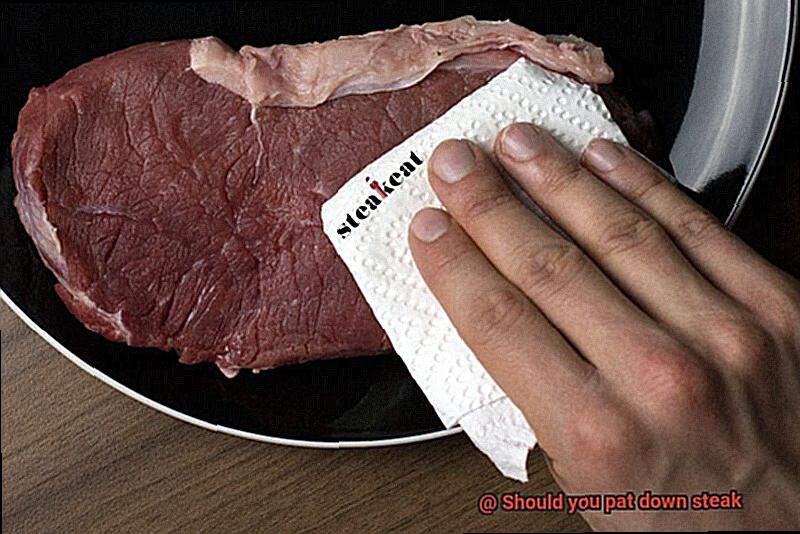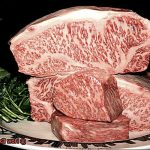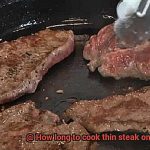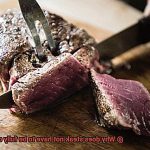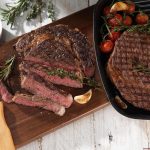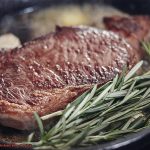Do you crave a succulent steak cooked to perfection? If your answer is yes, then you know that achieving the perfect crust on your steak is essential. However, is patting down your steak with paper towels or kitchen cloth necessary? Should you pat down the steak?
The debate about whether or not to pat down steak has been ongoing for years. Some people swear by it, saying that it’s crucial in creating a crispy exterior. Others argue that it’s pointless and can even ruin the natural juices inside the meat. As an expert on this topic, I have extensively researched it to provide readers with a comprehensive answer.
In this blog post, we will explore the pros and cons of patting down steak, including how it affects cooking time, texture, and flavor. We will also discuss alternative methods for achieving a dry surface such as leaving the steak uncovered in the fridge or using a hairdryer – yes, you read that correctly.
Whether you’re a seasoned steak lover or new to cooking beef altogether, keep reading to find out if you should be patting down your steak or leaving it au naturel.
Contents
What is Patting Down Steak?
One question that often arises is whether to pat down your steak before cooking it. In this post, we’ll explore the reasons for and against this practice.
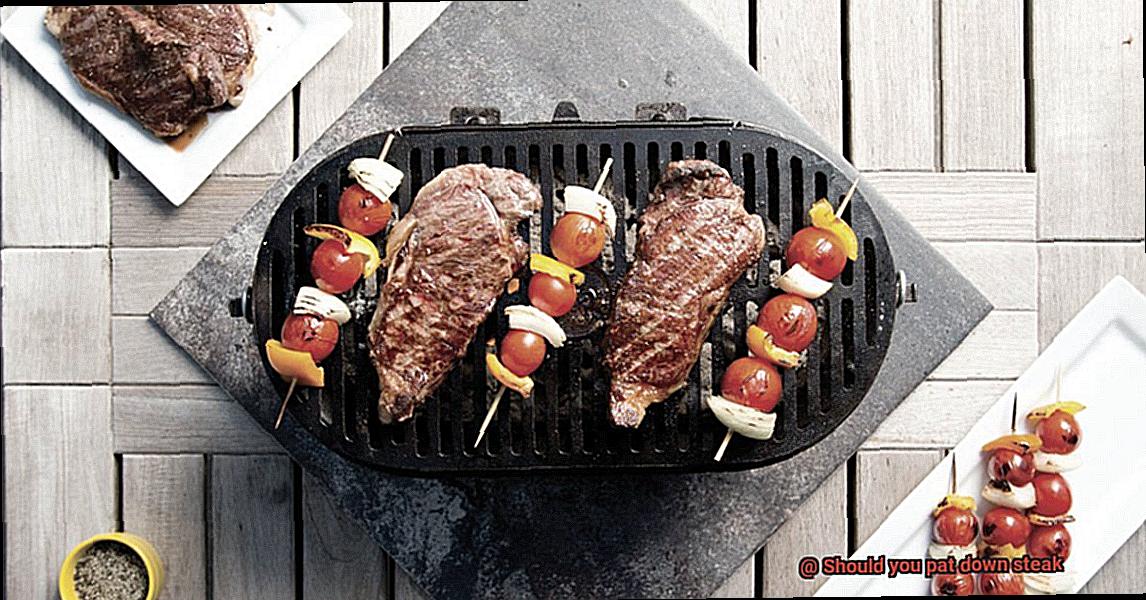
Patting down steak refers to using paper towels or a clean cloth to dry the surface of a steak before cooking it. Many chefs and cooks believe that patting down steak is an essential step in preparing a perfect steak, while others argue that it’s unnecessary or even detrimental to the quality of the meat.
The reason for patting down steak is to remove any excess moisture on the surface of the meat. When a steak is placed on a hot pan or grill, any moisture on its surface will turn into steam, which can create a barrier between the meat and the cooking surface. This can result in a less-than-ideal sear and can also cause the steak to stick to the pan or grill.
So, by patting down your steak with paper towels before cooking it, you are ensuring that your steak gets a good sear and doesn’t stick to anything.
However, some experts argue that patting down steak can also remove some of the natural juices and flavor of the meat. The juices are what makes a steak juicy and flavorful, so wiping them away with a paper towel can make your steak less enjoyable. Additionally, some chefs argue that leaving some moisture on the surface of your steak can help it develop a better crust when seared.
Ultimately, whether or not you should pat down your steak before cooking largely depends on personal preference and your desired outcome. If you prefer a more evenly seared and less sticky steak, then patting it down may be a good option for you. However, if you want to maximize the natural flavor and juiciness of your meat, then skipping this step may be best.
If you do decide to pat down your steak, be sure to use a clean paper towel and gently press down on the meat rather than rubbing it vigorously. And remember, sometimes simple is best – a good quality steak doesn’t necessarily need any additional help in the flavor department.
In conclusion, patting down your steak before cooking isn’t necessarily a right or wrong answer. It’s all about experimenting with different techniques and finding what works best for you and your taste preferences.
Benefits of Patting Down Steak
One question that frequently arises is whether or not to pat down your steak before cooking it. As an expert in this field, I am here to tell you that patting down your steak has numerous benefits that will elevate your cooking experience and make your steak taste incredible.
Patting down your steak is the key to achieving a crispy, caramelized exterior. By removing any excess moisture on the surface of the meat, you ensure that it forms a beautiful crust when it hits the hot pan or grill. A dry surface is essential for creating a mouthwatering, restaurant-quality steak at home.
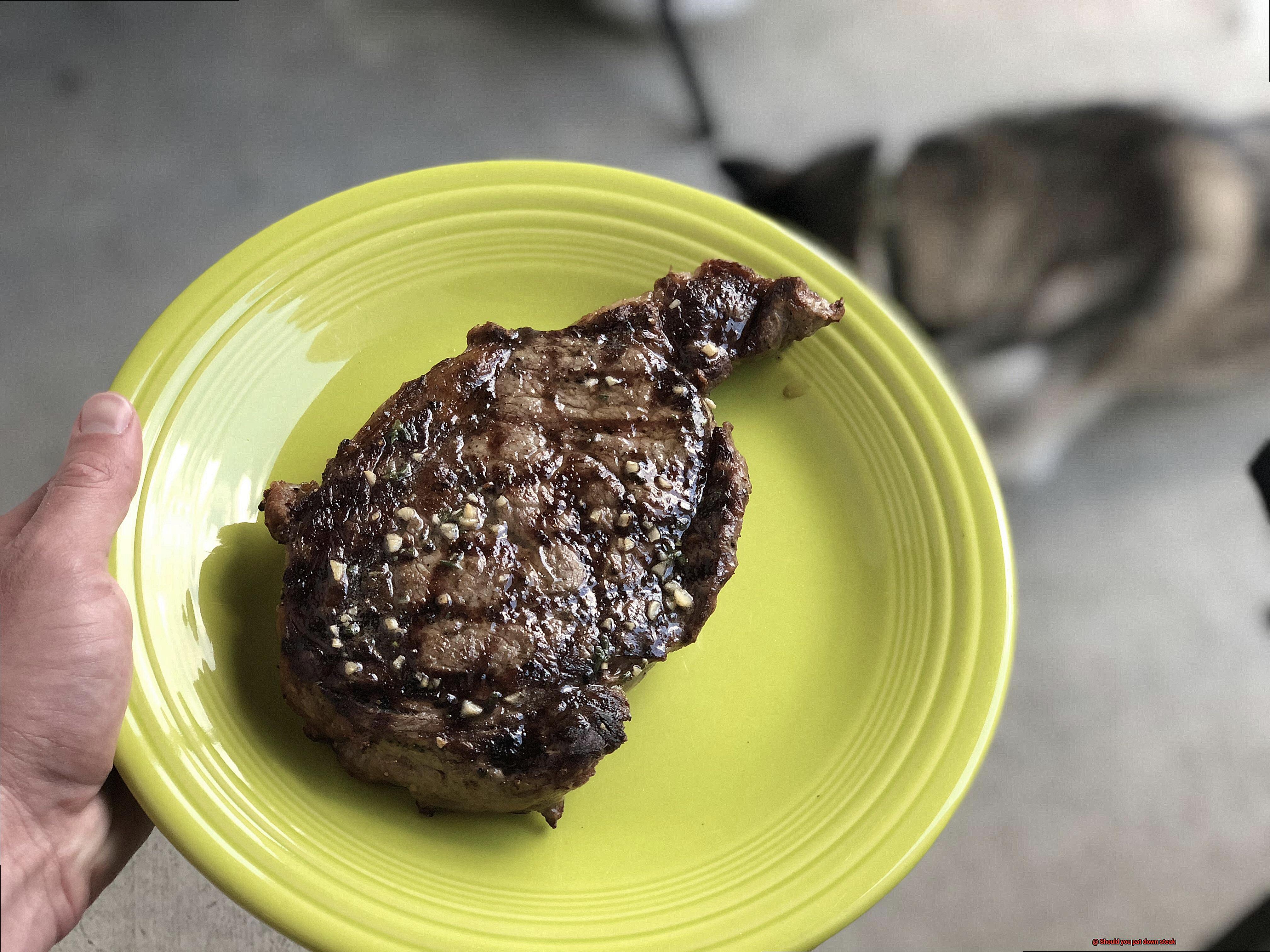
But wait, there’s more. When you season your steak with salt and other spices, they can sometimes get trapped in the moisture on the surface of the meat. By patting it down first, you ensure that the seasoning sticks to the meat and doesn’t get washed away during cooking. This means that every bite will be packed with rich, flavorful goodness.
Even cooking is another significant benefit of patting down your steak. Excess moisture on the surface of the meat can create steam when it hits the hot pan or grill, which can interfere with the cooking process and result in unevenly cooked steak. By patting it down first, you ensure that the heat is evenly distributed across the surface of the meat for consistent cooking throughout.
So, remember, patting down your steak before cooking is crucial for achieving a crispy crust, ensuring proper seasoning, and even cooking.
It may seem like a small step, but it can make all the difference in creating a delicious, restaurant-quality steak at home.
Drawbacks of Patting Down Steak
Firstly, one of the main concerns with patting down your steak is that it removes some of the natural juices and flavors from the meat. It’s like sucking the life out of your steak.
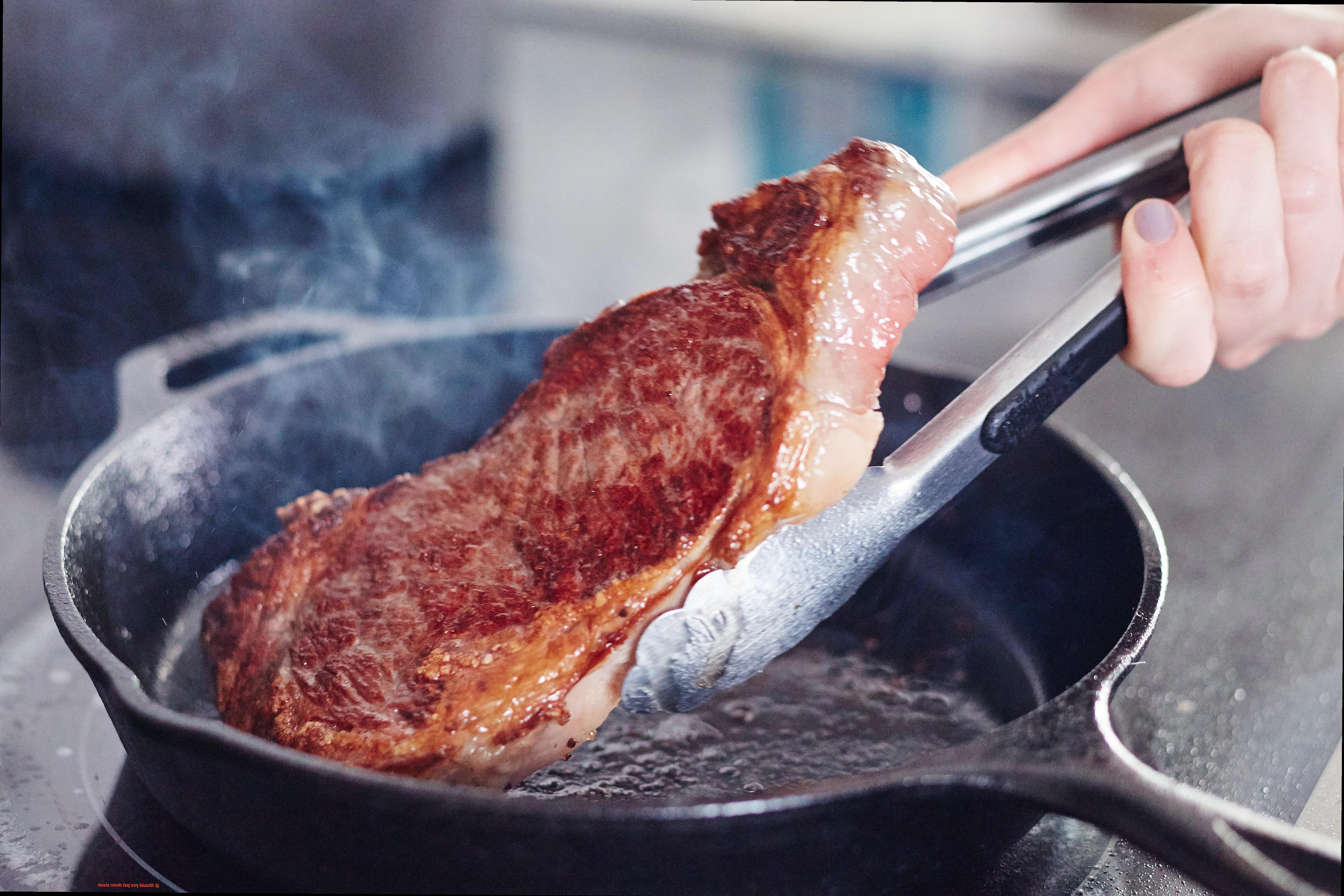
Those juices are what makes the meat tender and juicy, and when you pat it down with a paper towel or cloth, you’re essentially taking away some of its deliciousness. This can result in a dry, less flavorful steak that just doesn’t hit the spot.
Another issue with patting down your steak is that it can cause uneven cooking. If you remove too much moisture from one area of the steak, that part may end up cooking faster than the rest of the meat.
This can result in overcooked areas and undercooked spots, which is not what you want when it comes to a perfect steak.
Some people even argue that patting down your steak can spread bacteria around on the surface of the meat.
This is because when you use a paper towel or cloth to pat down your steak, you may inadvertently be transferring bacteria from your hands or the surface where the meat was resting onto the steak itself. While cooking the steak will kill any harmful bacteria, it’s still important to handle raw meat carefully to minimize any risks.
So, while patting down your steak may seem like a good idea to remove excess moisture and promote even cooking, it’s important to consider these potential drawbacks.
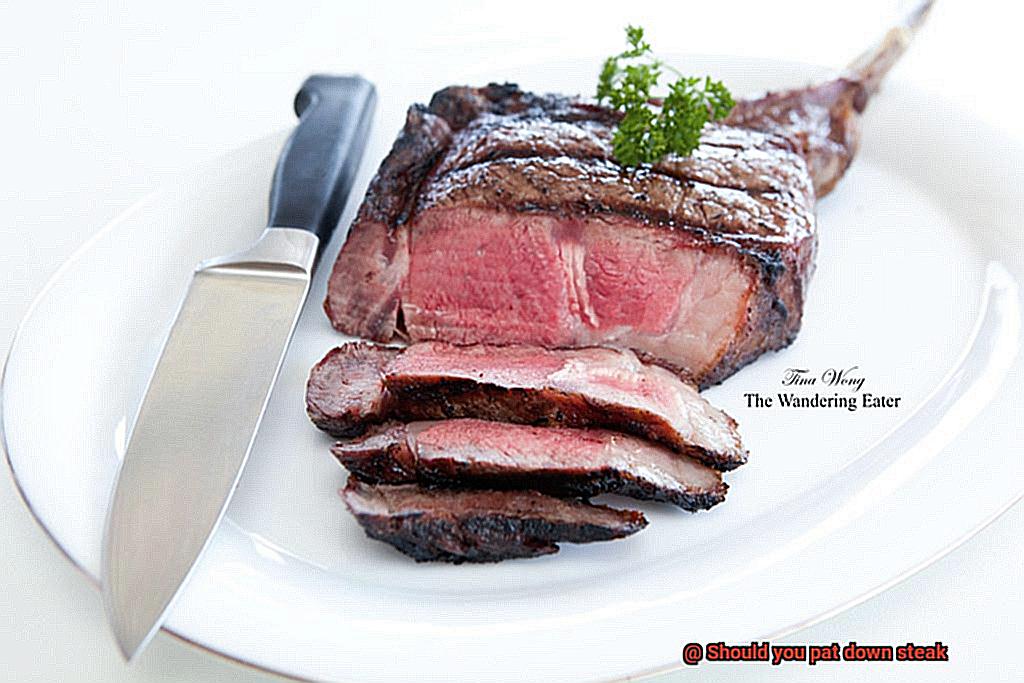
Ultimately, how you want to cook your steak is up to you – but sometimes less really is more. Let those delicious natural juices stay in your steak and let it cook evenly on its own.
Different Cuts of Steak and How to Pat Them Down
The way you pat down your steak can also have a major impact on its texture and flavor.
First up is the rib eye, a beloved cut known for its marbling and tenderness. To avoid a dry and tough steak, use a light touch when patting it down with a paper towel or clean kitchen towel. Pressing too hard can cause the fat to render out, leaving you with a less-than-perfect meal.
Next on our list is the filet mignon, famous for its delicate nature and buttery texture. To prevent breaking apart this tender cut, gently pat it down with a paper towel or clean kitchen towel. Take your time and remove any excess moisture without being overly aggressive.
For tougher cuts like flank or skirt steak, a more assertive patting technique may be necessary. These cuts have less fat marbling and need some tenderizing before cooking. Use a meat mallet or the back of a heavy skillet to pound the steak gently before patting it down with a paper towel or clean kitchen towel.
No matter what type of steak you’re cooking, patting it down before seasoning and cooking is crucial. This helps to remove excess moisture on the surface of the meat, ensuring that it sears properly instead of steaming. Remember to take it easy and don’t overdo it when patting down your steak.
There you have it – five different cuts of steak and how to pat them down for optimal results.
Tips for Patting Down Steak
If so, then you know that patting down your steak before cooking it is an essential step in achieving that mouthwatering dish. While it may seem like a small detail, patting down your steak can make all the difference in the world when it comes to taste and texture.
Here, we’ll explore why patting down steak is important and provide some tips to keep in mind when doing so.
Use paper towels or a clean cloth
Before cooking your steak, use paper towels or a clean cloth to pat it down and remove any excess moisture.
This is important because excess moisture can prevent the steak from developing a nice crust when searing, resulting in an unappetizing dish.
Be sure to use a clean and dry towel or cloth to avoid adding moisture back onto the surface of the meat.
Don’t press too hard
While patting down your steak, be gentle and don’t press too hard. Pressing too hard can flatten the meat, squeeze out its juices, and result in a dry and tough steak.
Instead, be patient and take your time when patting down your steak.
Pat down both sides
It’s crucial to pat down both sides of the steak, not just one. This ensures that both sides develop a nice crust and cook evenly, resulting in a perfectly cooked steak.
Let the meat come to room temperature
Allowing your steak to come to room temperature before patting it down is key in ensuring even cooking and a nice sear on the outside. This step allows for better heat distribution throughout the meat.
Use a dry rub
If you’re seasoning your steak with a dry rub, make sure to pat it down after applying the rub. This helps to ensure that the rub sticks to the surface of the meat and doesn’t fall off during cooking. Be sure to season your steak after patting it down to avoid drawing out excess moisture.
By following these tips, you can achieve a perfectly seared and juicy steak every time. Patting down your steak may seem like a small detail, but it can make all the difference in the world when it comes to taste and texture.
Remember to use a clean paper towel or cloth, be gentle, pat down both sides, let the meat come to room temperature, and use a dry rub to achieve that perfect crust.
Is It Necessary to Pat Down Steak?
As an expert on cats, I can tell you that patting down your steak before cooking is just as important as grooming your feline friend. Just like how grooming helps to remove excess fur and prevent matting, patting down your steak helps to remove excess moisture and ensure even cooking.
Think of it this way – when you pet your cat, you’re not pressing down too hard or aggressively rubbing its fur. Similarly, when patting down your steak, you want to be gentle and avoid pressing too hard. This ensures that the meat retains its natural juices and doesn’t become dry and tough.
Furthermore, just like how cats have different coat types that require different grooming techniques, different cuts of steak require different patting techniques.
For example, a delicate filet mignon requires a gentle patting technique to prevent it from breaking apart, while tougher cuts like flank or skirt steak may require a more assertive patting technique to tenderize the meat.
By taking the time to pat down your steak properly, you can ensure that it cooks evenly and develops a beautiful crust.
Alternatives to Patting Down Steak
While this practice has been a go-to for many chefs, it may be removing flavor and juices from your steak. Luckily, some alternatives can help promote juiciness and flavor in your steak.
One alternative is to let your steak rest at room temperature for around 30 minutes before cooking. This will help reduce surface moisture without the need for patting down. By allowing your steak to come to room temperature, you’ll promote even cooking and retain the natural juiciness of the meat.
Another option is to try a dry brine. This involves seasoning your steak with salt and letting it sit uncovered in the refrigerator for several hours or overnight.
The salt will draw out moisture and create a flavorful crust on the surface of the steak, just like patting it down with paper towels.
If you prefer searing your steak in a hot pan or grill, try not to move it for a few minutes on each side until a crust forms on the surface. This will help lock in the natural juices and flavor of the meat.
Remember, avoid overcooking your steak by using a meat thermometer to ensure that it’s cooked perfectly.
Finally, some chefs recommend using a technique called reverse searing. This involves cooking your steak in a low-temperature oven until it reaches an internal temperature of about 10-15 degrees below your desired doneness, then finishing it off with a quick sear in a hot pan or grill.
This method allows for more even cooking throughout the steak and results in a juicier, more flavorful end result.
There are several alternatives to patting down steak that can help enhance its flavor and juiciness. Experiment with these methods and see which one works best for you.
Conclusion
In conclusion, the decision to pat down your steak before cooking is entirely up to personal preference and desired outcome. If you’re looking for a crispy exterior and want to prevent sticking to the pan or grill, patting down with paper towels or a clean cloth can be helpful. However, keep in mind that it may also remove some natural juices and flavor from the meat.
To ensure optimal results when patting down your steak, use a gentle touch, pat both sides of the meat evenly, and let it come to room temperature before cooking. You can also enhance the flavor and crust of your steak by using a dry rub.
If you prefer not to pat down your steak, there are other techniques you can try. Letting it rest at room temperature before cooking or using a dry brine can be effective alternatives. You can also experiment with searing your steak without moving it for a few minutes on each side or using the reverse searing method.
Ultimately, there is no one “right” way to cook a delicious steak – it’s all about finding what works best for you. So don’t be afraid to try out different techniques until you discover your perfect recipe.

